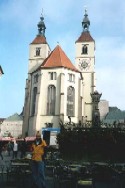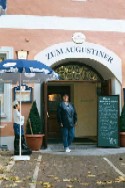   |
| As with most cities on our trip,
Regensburg is a city well over 1000 years old. It started as a Roman fort in 90 AD on a site of
an older Celtic settlement located at the confluence of the rivers Donau and Regen. In 179 AD,
under the reign of Emperor Marcus Aurelius, a fort named Castra Regina ("Fortress by the River Regen")
was built as a base for Third Italic Legion. "Regensburg" had its future name. Castra
Regina became the capital and the main military center of the Roman province of Raetia. The
stone plaque recording the foundation of the town, which is kept in the city museum, and the
Porta Praetoria near the Bischofshof are the most important surviving monuments of the Roman era.
When Charlemagne deposed Duke Tassilo III in 788, Bavaria became part of the Franconian empire and Regensburg became the main seat of the Carolingian rulers of the south-eastern part of Germany. Regensburg remained the preferred seat of the East Franconian Kings under Charlemagne's successors. In 739 the Diocese of Regensburg was founded. The stone bridge spanning the Donau was built between 1135 and 1146. This marvel of medieval engineering served as a model for many bridge building projects, for example the Charles Bridge in Prague built 200 years later. Regensburg is home to number of history museums: Kepler Memorial House, the History Museum, Diocesan Museum of St. Ulrich and the Cathedral Treasury. BR> Within the city there are many cathedrals belonging to the Diocese of Regensburg: the Gothic cathedral of St. Peter (begun in 1275, but not completed until the nineteenth century) the Old Cathedral, or St. Stephanskirche (end of tenth century) the Church of St. Emmeram (eleventh century) the Church of St. Jakob (twelfth century) the former Dominican Church of St. Blasius (1273-1400). The city also is and was the home of an incredible amount of monastic orders: the Antonites (1444-1540), three branches of the Augustinians (1267-1810, 1730-1810, 1138,1803), the Dominicans (est. 1233), two branches of the Franciscans (1221-1799, 1630-1802), the Kapuziner (1613-1810), two branches of the Carmelites (1635-1811, 1290-1367), four branches of the The Benedictines (983-1588, 700s-1810, 1089-1814, 1075-1552)... Today, the only establishment bearing the Augustinian name, is Zum Augustiner, a great beer pub. |
Continue your virtual visit on these websites:
Regensburg official website
Diocese of Regensburg
Monasteries in Bavaria
A Picture Gallery of Regensburg, by Historic Highlights of Germany
Nice Collection of Private Pictures, by Donna and Chris Wren
Photographs (c) 2001 Radim and Lisa Kolarsky
Last updated October 28, 2001